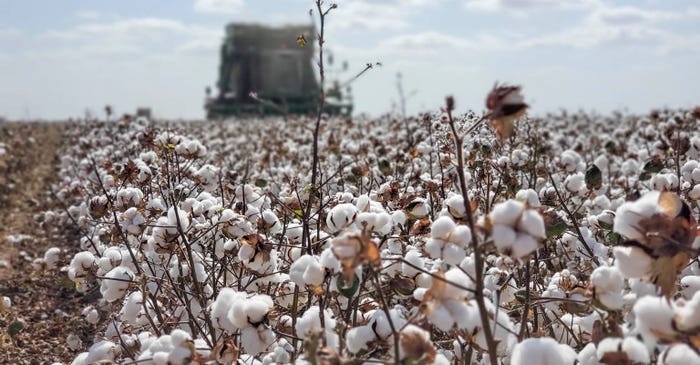
Cautious optimism, a cliché perhaps, but an apt description of how Oklahoma cotton growers and observers view 2024 prospects.
“We’re just getting ready for the 2024 crop,” says Clint Abernathy, who farms with his sons, Justin and Jarod, near Altus.
“Moisture is better than it has been for the last two years,” Abernathy says. “The district had virtually no rain last year and the year before. We made almost no crops. Now, the lake (Altus-Lugert) is up some, not where we need it, but this is the time of year when we can expect rain and runoff into the lake.”

Jenny Dudak, the new Oklahoma State University Extension cotton specialist (Photo by Shelley E. Huguley)
Jenny Dudak, the new State Extension cotton specialist, agrees that a bit of optimism is warranted. “Soil moisture in Southwest Oklahoma is better this spring than it has been in recent years,” Dudak says.
She says last year’s cotton crop was pretty bad. “A lot of acres in Southwest Oklahoma were zeroed out by insurance. The pressure of another potential crop failure on cotton acres in 2024 spurred talk last fall about switching from cotton to dryland corn; however, I am optimistic cotton acres will remain strong.”
Planting intentions
Harvey Schroeder, Oklahoma Cotton Council, says the situation “is a mixed bag. For some farmers, cotton is their sole crop, so we will plant cotton. We’ve seen some wheat land go into cotton.”
He says cotton prices have dipped recently. “Still, we have to grow it in order to sell it.”
Abernathy says irrigation may depend on more rainfall.
“The way it sits now, we probably don’t have enough water in the lake to irrigate. It would not be worth turning the system on. But the lake level has come up, and it would not take much more runoff to get to that level.

Without some rain, there are concerns there won't be enough water in the Altus-Lugert Lake to irrigate. (Photo by Shelley E. Huguley)
It’s not there yet. But we are expecting rain. May is a big month.”
They are on the cusp of planting. “We normally wait until the second week of May if moisture and temperature conditions are right. We like to wait a bit longer than we used to. We only want to plant one time, especially with cotton seed prices where they are.
Planting patience important
“We’ve learned the hard way to be patient. A long time ago, a bag of cottonseed was $25; now it’s $450, so we don’t want to chance planting early.”
“I recommend patience,” Dudak says.
“Cotton farmers will start planting in the next two weeks if temperatures are good,” she says.
“Planting conditions are a hot topic this time of year. Our soil temperatures are fair, ranging from the low to the mid-60s. However, I am concerned about air temperatures and would caution against planting too early in case temperatures taper, resulting in delayed emergence, slow-growing cotton, or stand loss.
“In parts of the state, thrips can also become an issue in cotton with delayed growth due to cool temperatures.”
She says soil and air temperature and moisture are crucial for planting decisions.
“I would recommend keeping a close eye on soil temperatures and the forecast when making planting decisions. For this year, from what I have seen, the first full week of May shows potential.”
Abernathy says they have been getting some rain, “about a half-inch, but we need a good soaker.” Annual rainfall for the region is about 25 inches a year, he says. “But we could get six inches all at once.”
Cover crops
He intends to plant about the same acreage as last year. He plants dryland and irrigated cotton, and
“hopes for good moisture.”
He plants everything behind a wheat cover crop. “We grow some wheat for grain, so we have the option to harvest or terminate it.”
He plants some wheat acres specifically for cover and terminates ahead of planting cotton. “We usually terminate around the first of April. We harvest for grain at the end of May.”

Harvey Schroeder, Oklahoma Cotton Council, expects Oklahoma farmers to plant 450,000 cotton acres. (Photo by Shelley E. Huguley)
He says the wheat looks good. “Some looks excellent. We’ve had some pretty good rains on it, but we could use one more.”
Dudak says cotton price and moisture are chief concerns as farmers prepare to plant.
Crop insurance
Schroeder expects Oklahoma farmers will plant around 450,000 acres. “That’s just me,” he says. “USDA has us down to 340,000 to 350,000. A lot will depend on the price of insurance.”
It’s a tough call, he says, with producers getting only 60% of insurance money from a failed crop. If it’s zero, they need 100%. But they can’t farm without it.”
He says a zero year hurts everyone, farmer and infrastructure. “It hurts ginners, seedsmen, suppliers, and all across the board when farmers can’t harvest.”
Dudak hopes to see a cotton rebound in 2024. “I hope with the rain we received this winter and spring, 2024 will prove to be a successful year for cotton in Oklahoma."
She says she’s just getting her bearings with her new job. She just earned her Ph.D from Oklahoma State and is beginning to start networking with Oklahoma cotton farmers.
“Statewide, I think there is a sense of optimism for cotton,” she says, “and I am personally excited for this 2024 growing season.”
About the Author(s)
You May Also Like






